Photo Feature: Thailand's Last Executioner
Interview With An Executioner
by Richard S. Ehrlich
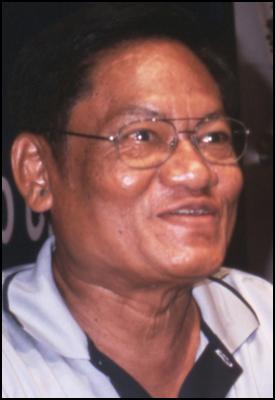
Chavoret Jaruboon, a Buddhist who describes himself as Thailand's "Last Executioner."
Photo copyright by Richard S. Ehrlich
BANGKOK, Thailand -- He shot 55 men and women in the back, killing them with a burst of bullets aimed at the heart, while each person was tied to a wooden cross.
"I think the system of execution has become more humane, compared with when they hammered nails under people's fingernails, and did other torture, or whiplashed them before they cut their heads off," Chavoret Jaruboon said in an interview.
"Those things are in the past."
Mr. Chavoret, 58, is a Buddhist who describes himself as Thailand's "last executioner."
"Every Buddhist monk would say that killing someone is a sin. But the question is whether you take pleasure in killing that person," Mr. Chavoret said.
"What I have seen is that these prisoners have done bad to others, and they are incarcerated because of their own karma."
After two decades as an executioner, Mr. Chavoret switched jobs three years ago to become head of foreign prisoners' section at Bangkok's dreaded Bang Kwang Central Prison, where he coordinates the detention of Americans, Europeans, Africans and Asians.
Years ago, sarcastic foreigners dubbed the sprawling compound "The Bangkok Hilton," and it now cages about 500 foreign inmates from 44 countries, serving various sentences.
People still get sentenced to death row in Bang Kwang Prison. A number of Thais -- alongside several foreigners from Burma, Laos, China, Malaysia and one from Nigeria -- currently await lethal injection.
Lethal injections began in December 2003, when four people were executed the same day, including three busted for 115,000 methamphetamine pills.
Death row inmates suffer a nebulous nightmare in Thailand, because they do not know when they will be yanked from their group's grim cell.
They spend years struggling to survive in the tropical prison, forming intense emotional bonds with other death row convicts, but can be chatting in an intimate conversation when suddenly a guard enters the group's cell, and the person is seized.
"Before I became an executioner, I was an escort for death row prisoners in Bang Kwang. It was gloomy. The door opens, and the guard points, and he says: 'You!'
"Some inmates immediately start grabbing things around them, wildly reaching out, trying to touch things, and get it together. I could see them, the blood draining from their faces," he said.
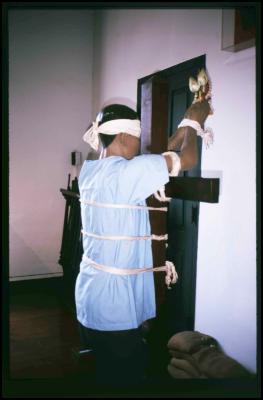
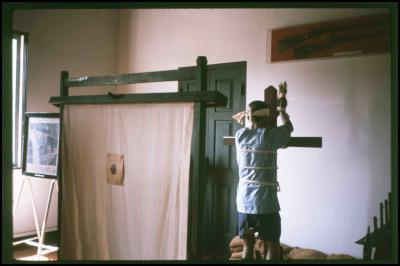
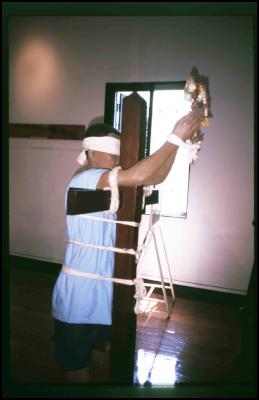
A mannequin, displayed by Thailand's Department of Corrections, shows how a condemned person is tied to a wooden cross, to be shot in the back by an executioner who stands off to the left of the photo, aiming at a heart-high target placed on a cotton panel.
Photos copyright by Richard S. Ehrlich
Mr. Chavoret was one of about a dozen executioners who worked in shifts at Bang Kwang, using a 9-mm submachine gun fitted with a silencer.
"I have executed 55 people, including three women."
Unlike firing squads in some countries where a line of riflemen simultaneously shoot a lone prisoner, Thailand's system involved only one executioner to kill one convict.
"One gun per prisoner," Mr. Chavoret said.
"I shot at the person's back, at the heart. The rule was we could shoot up to 15 bullets. So I would fire a burst of single shots, 'bam-bam-bam-bam-bam'."
Some historians claim executions in Asia are often performed behind the person's back, and not face-to-face, because many people fear the dead person's ghost may later recognize the executioner and take revenge.
By remaining behind the prisoner, the executioner avoids being the last face that the condemned man sees.
To ease the executioner's tension, a big cloth panel with a heart- high target is placed between the shooter and person who is tied, standing, to a wooden cross.

In 1911, a French newspaper published this illustration of a beheading in Siam, as Thailand was known at that time, and described it as: "Une Execution Capitale Au Siam."
Photo copyright by Richard S. Ehrlich
"When Thailand had the system of beheadings, they also chopped the person's neck by jumping at them from behind. Maybe it was because the ghost might come back to haunt them," he said.
Beheadings, abolished in 1934, included slicing and dicing the dead person's headless body so it could be fed to crows and vultures.
The decapitated head would be impaled on a sharp pole, which was stuck in the ground, so the head could be displayed to the public.
"I'm not going to say if I am now for, or against, the death penalty. But what I want to tell you is that Thai law still has this kind of penalty, and I don't want anyone to have to get to that point.
"The most important thing is not to kill the wrong guy, or a scapegoat.
"There are some people who said they were innocent even when they entered the execution room, but it is not my responsibility to determine that."

A painting, displayed by Thailand's Department of Corrections, shows the official, royally mandated torture and execution of people in Thailand in the 15th century.
Photo copyright by Richard S. Ehrlich
Mr. Chavoret wrote a book titled, "The Last Executioner," which was published several months ago.
Today, he tries to enjoy life with his wife, two sons and one daughter.
"I was 55 when I did my last execution. I do get stressed from killing people, of course. But I try to look at the positive side.
"I have to remind myself that I did my duty, I did what the justice system told me to do, as an executioner. I am not completely happy with it, but I have to look at the bigger picture and try to understand things."
He favors lethal injection instead of shooting people in the back.
"It is more humane, because the body remains in the same condition, in its natural condition. The body is not going to be shot through the heart."
"I think the death penalty is to prevent crime, and to make an example of criminals. It is like when we had a campaign in Bangkok against littering. During that time, people did not throw things onto the street. But when we took the signs down, people went back to littering.
"We are better if we are repressed and controlled. We behave better. Thai people need to be put under some control, so we behave better."
Brutal behavior modification peaked in Thailand during the 15th century, when a royal Treason Act allowed executioners to be sadistic.
"Break open the skull, and drop in red-hot iron, so the brain spouts out like boiling liquid," the act advised.
"Shackle both elbows and both knees, and insert a stake, making movement impossible. Then, apply a flaming torch to the body, until death," the Treason Act said, according to "Discovering Ayutthaya," a book by Thai historian Charnvit Kasetsiri, describing King Rachathirat II's 1424-1448 reign.
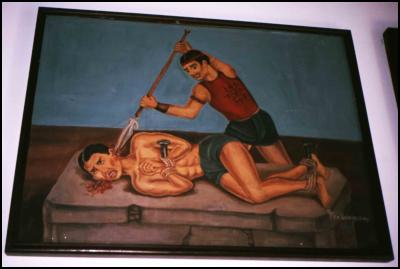
A painting, displayed by Thailand's Department of Corrections, shows the official, royally mandated torture and execution of people in Thailand in the 15th century.
Photo copyright by Richard S. Ehrlich
Copyright by Richard S. Ehrlich, who has
reported news from Asia for the past 28 years, and is
co-author of the non-fiction book of investigative
journalism, "HELLO MY BIG BIG HONEY!" Love Letters to
Bangkok Bar Girls and Their Revealing Interviews. His web
page is http://www.geocities.com/asia_correspondent


 Binoy Kampmark: Olfactive Implications - Perfume, Power And Emmanuel Macron
Binoy Kampmark: Olfactive Implications - Perfume, Power And Emmanuel Macron Martin LeFevre - Meditations: True Abundance
Martin LeFevre - Meditations: True Abundance Binoy Kampmark: Junk Science And Bad Policing - The Homicide Prediction Project
Binoy Kampmark: Junk Science And Bad Policing - The Homicide Prediction Project Keith Rankin: Rational Expectations, Intelligence, And War
Keith Rankin: Rational Expectations, Intelligence, And War Peter Dunne: Dunne's Weekly - Is Andrew Little Wellington's Mayor-In-Waiting?
Peter Dunne: Dunne's Weekly - Is Andrew Little Wellington's Mayor-In-Waiting? Gordon Campbell: On Peter Dutton’s Fading Election Prospects.
Gordon Campbell: On Peter Dutton’s Fading Election Prospects.